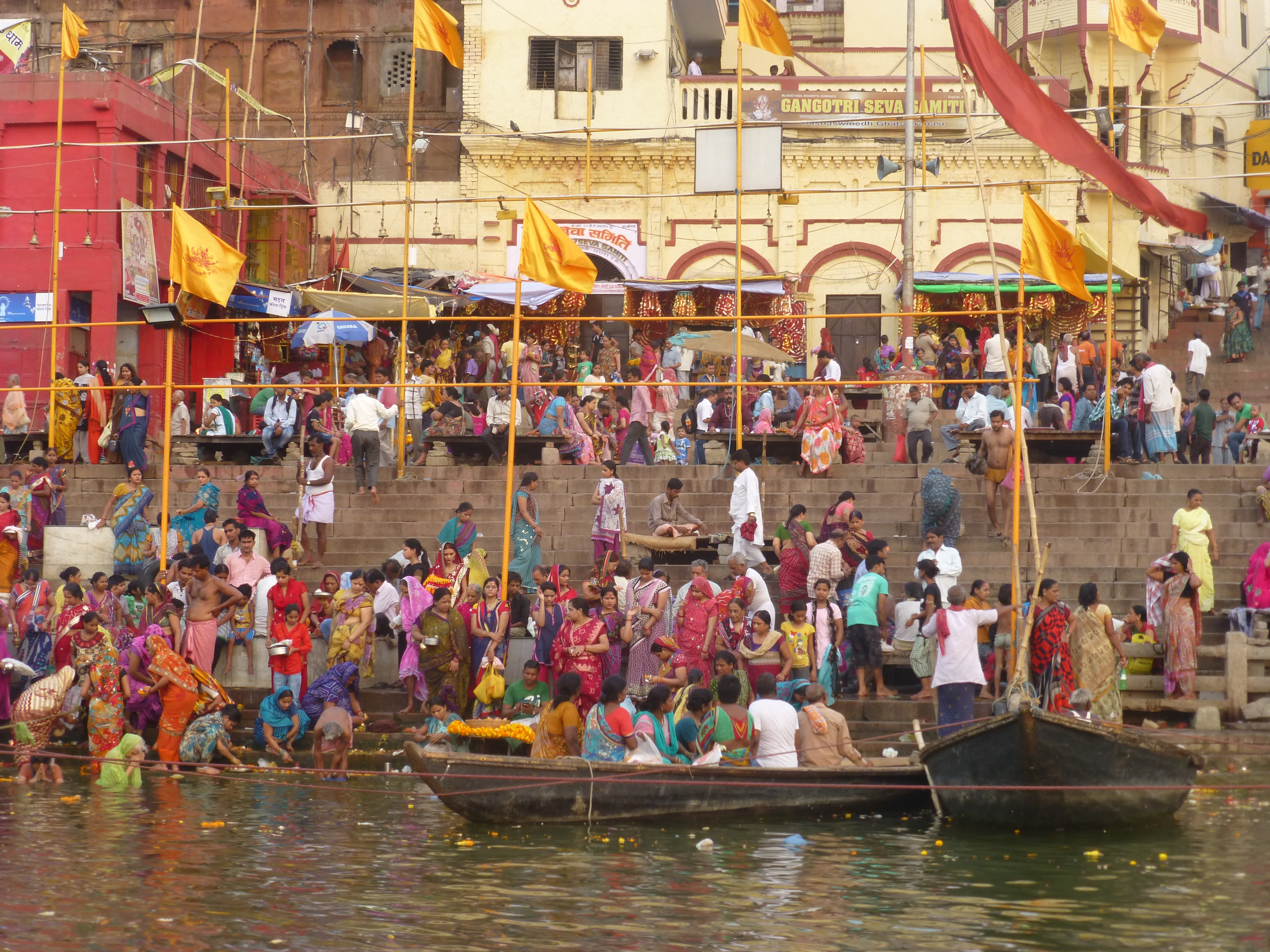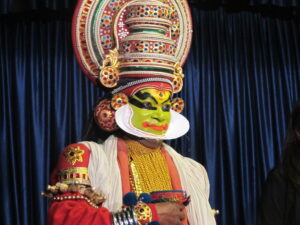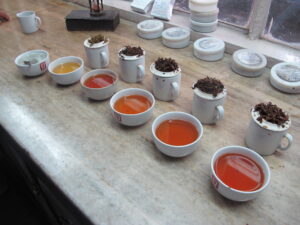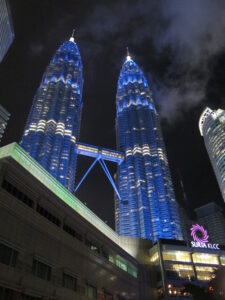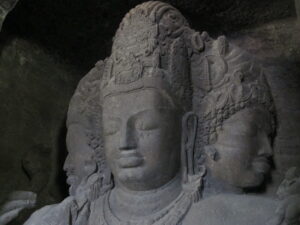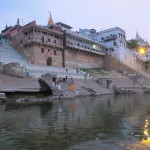
Traveling at dawn by river along the stepped riverbanks – the ghats – of Varanasi is surprisingly serene.
In this early light, at 5 AM, the holy river Ganges flows imperceptibly northward, a half-kilometer wide grey sheet stretched taut by the distant bank.
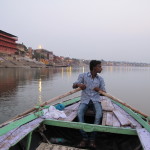
Our boatman, wiry, twenty-five or so, pulls quietly but firmly on oars tied with cloth strips to the thwarts. The flaking blue paint we sit on has not been retouched for a long while, but the boat seems able to stay afloat, at least for the 90 minutes or so we expect. Eager to guide as well as propel us, he dutifully ticks off the names of the ghats and some interesting facts about several of them.
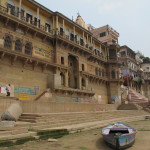
We pass other boatmen, sure that few customers will need them on an overcast morning, curled up still in the fore-end of their boats. Ours had scampered up the steps of Tulsi Ghat like a nimble goat to deliver the well-honed pitch all of them develop. For $5, we agreed, he would take us along the ghats and back, a reasonable price.
The city is just awakening, but there is much of daily life already at ghat’s edge.

Men primarily, but also some women, are here to wash themselves for the day, but not in any religious ritual. Some lather themselves and then their clothes to a gleaming froth. Families and groups of young men gather to swim or just float about, now when it’s merely warm and later when the heat and humidity oppress. A few toss lines in for fish.
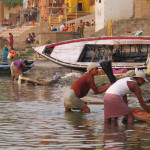
Laundrymen are already beating their slate rocks mercilessly with clothing; soon shirts, bed linens, tablecloths, saris and everything else the city needs cleaned will be laid across the steps and platforms to dry.
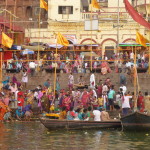
The devout in white robes or diaper-like wraps fill their cups from the Ganges, ceremoniously pour water on themselves to be cleansed of their sins and then pour the rest back into the river. Others of all ages carefully descend the steps so they can pray at the water’s edge and float floral candles in prayer. One elderly man slips on the steps below the water’s surface, immersing himself more suddenly than he expected, as his family members struggle to steady him.
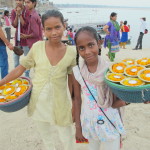
There is no commercial activity on the ghats except the sale of flowers or candles and so on for these pilgrims – and occasional chai sellers. The flaking, sun-blanched paint of the buildings that line the ghats is only sullied by hand-painted advertisements you might have seen in Paris back in the early 20th century – for the organic bakery at Asi Ghat or the clean Raj Hotel at Man Mandir Ghat.
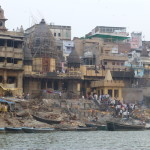
The Ganges is the wellspring of spiritual life for pilgrims like those we watch, many of whom will follow the sacred routes and stations around the ghats and the city. And Varanasi itself, at the virtual center of the Hindu universe, is the ideal exit point from the earthly life. Many come here to die so they will be guaranteed enlightenment in the afterlife. They are cremated right on the banks of the river at one of two funerary ghats. At the principal cremation site, Manikarnika Ghat, we saw one body on its final human passage. Four men struggled to carry the wooden palette down the uneven hillside to the river’s edge for a sprinkling of water. They then hauled the body back up to a pit. They removed the colorful ceremonial garments, leaving the body swathed in white, then carefully balanced the palette on a spire of logs which had already been lit to a low bonfire inside the pit. Once the body is consumed, the ashes that remain are spread about, awaiting re-immersion in the river when monsoons arrive. Cremations proceed round the clock, and tens of thousands finish their lives here each year, taking with them forests of logs on their pyres.
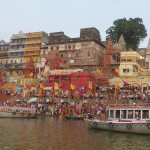
The activity of the living is most intense a bit to the south of the cremation ghat at Dashaswamedh, “the main ghat,” our boatman says. There, even at dawn, the sound of prayers on loudspeakers and ringing bells accompany a high density of pilgrims. On the water, a throng of tourists watch the spectacle, as their boatmen snuggle their boats close for picture-taking.
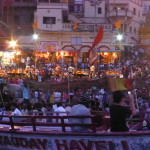
At night, even more boats return, as both the devout and curious onlookers cram the steps for the aarti ceremony. This is a nightly spiritual celebration, about 45 minutes long, filled with fire, light, incense, prayer and music. It’s a show that is intended as religious ritual, but is also part tourist spectacle.
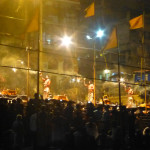
And the temples seem to stir with activity at all times. Even in the heat and humidity, as we walked the ghats the previous day, we saw visitors throng one of the most visible places of worship at the river. That’s the red and white striped temple at Kedara Ghat, dozens of steep steps above platform level. For ten minutes, one old woman labored intently up toward the temple, one slow step at a time, supported on each side by family members.
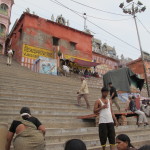
Inside, thirty or forty men sat in the atrium talking or praying, others walked contemplatively about the inner sanctum lined with plaques, while within the inner sanctum dozens more prayed loudly, lit incense or candles, or poured water on the lingam statue.
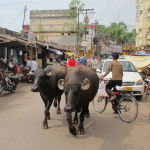
What struck us, however, is how Varanasi intensely throbs with mundane, earthly life as well as spiritual life. When we walked away from the river, we found the tumult of the Dashaswamedh Ghat squeezed into the constricted streets of the old town. We competed for walking room with the devout winding along their well-worn ancient trails, shoppers, brahma cows, goats, cycles and cycle-rickshaws, scooters, cart haulers, other walkers, businessmen, as well as police and soldiers with no discernible purpose.
During our stay, we prowled the medieval alleyways just west of the ghats. Here, the earthy can be overwhelming. Trodding the paving stones are herds of cows and occasional goats processing waste tossed in piles, and leaving heaps of dung in various stages of decomposition and disappearance. They even spill out onto the larger streets, where they are joined by noisy and incessant traffic. Yet the spiritual still holds its own. Small shrines ring out in the evening and morning with chants and bells, woven amid the smells of incense and dung, as do the many larger temples, domes and stupas.
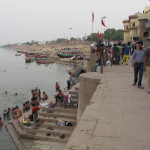
In the relative calm of our morning on the river, the boatman eased us back to Tulsi Ghat, still as quiet as we had left it. We headed in for a nap. When we awoke, all the sacred and profane activity of Varanasi had stirred up again, all the fetid and the sublime, and everything in between – India at its most extreme. And we weren’t here during a festival or special sacred time, when the intensity overflows.
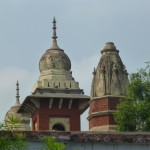
It’s no wonder that western visitors typically stay for just a day or two in the more refined cantonment area. Varanasi’s roiling, turbulent flow of life and death is tough to confront. Even the locals, we heard, can find living here a full-on challenge.
For Varanasi is not like the tranquil Ganges we had boated, but more like the river after the monsoon rains hit. Then the river churns along the ghats, mounting some twenty or thirty meters higher, up and over their steps, threatening the ageing buildings on its shore and swallowing the ashes of the dead.
(Also, for more pictures from India, CLICK HERE to view the slideshow at the end of the India itinerary page.)


